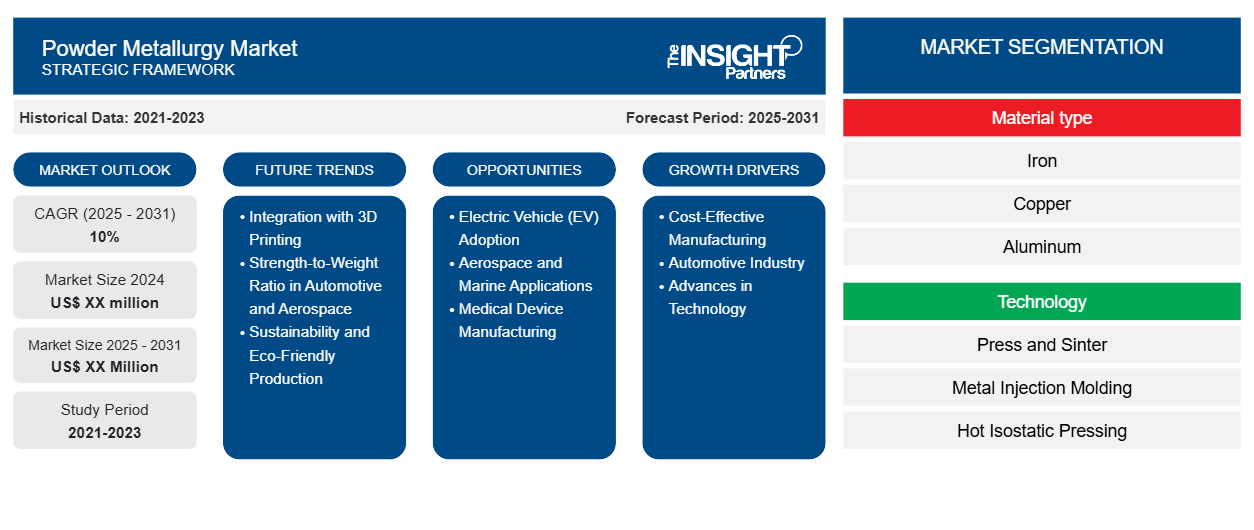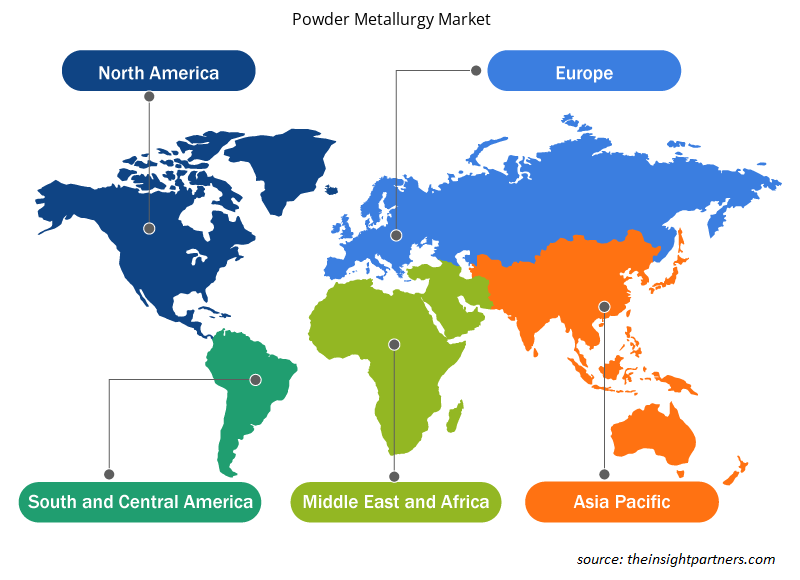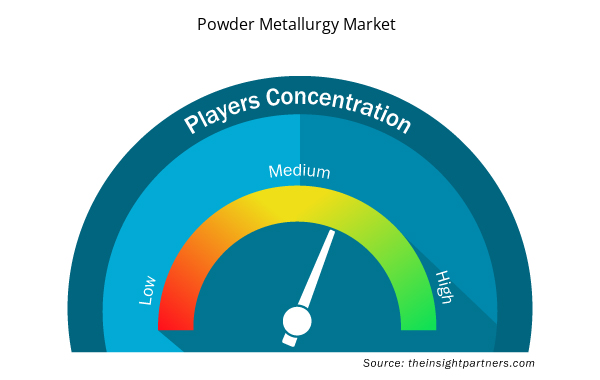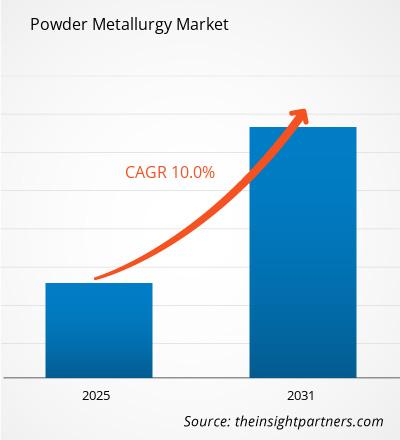Si prevede che il mercato della metallurgia delle polveri registrerà un CAGR del 10% dal 2025 al 2031, con una dimensione di mercato in espansione da XX milioni di dollari USA nel 2024 a XX milioni di dollari USA entro il 2031.
Il rapporto è segmentato per tipo di materiale (ferro, rame, alluminio, acciaio, altri), tecnologia (pressatura e sinterizzazione, stampaggio a iniezione di metallo, pressatura isostatica a caldo, produzione additiva di metallo, altri). Il rapporto presenta inoltre analisi basate sull'applicazione (automotive, elettronica, aerospaziale, medicina, petrolio e gas, altri). L'analisi globale è ulteriormente suddivisa a livello regionale e nei principali paesi. In termini geografici, il mercato è suddiviso in Nord America, Europa, Asia Pacifico, Medio Oriente e Africa e Sud e Centro America). Il rapporto offre il valore in USD per l'analisi e i segmenti di cui sopra.
Scopo del rapporto
Il report Powder Metallurgy Market di The Insight Partners mira a descrivere il panorama attuale e la crescita futura, i principali fattori trainanti, le sfide e le opportunità. Ciò fornirà spunti a vari stakeholder aziendali, come:
- Fornitori/produttori di tecnologia: per comprendere le dinamiche di mercato in evoluzione e conoscere le potenziali opportunità di crescita, consentendo loro di prendere decisioni strategiche informate.
- Investitori: condurre un'analisi completa delle tendenze relative al tasso di crescita del mercato, alle proiezioni finanziarie del mercato e alle opportunità esistenti lungo la catena del valore.
- Enti di regolamentazione: regolamentano le politiche e le attività di controllo sul mercato allo scopo di ridurre al minimo gli abusi, preservare la fiducia degli investitori e sostenere l'integrità e la stabilità del mercato.
Segmentazione del mercato della metallurgia delle polveri
Tipo di materiale
- Ferro
- Rame
- Alluminio
- Acciaio
- Altri
Tecnologia
- Pressa e sinterizzazione
- Stampaggio a iniezione di metallo
- Pressatura isostatica a caldo
- Produzione additiva di metalli
- Altri
Personalizza questo report in base alle tue esigenze
Riceverai la personalizzazione gratuita di qualsiasi report, comprese parti di questo report, o analisi a livello nazionale, pacchetto dati Excel, oltre a usufruire di grandi offerte e sconti per start-up e università
Mercato della metallurgia delle polveri: approfondimenti strategici

- Scopri le principali tendenze di mercato in questo rapporto.Questo campione GRATUITO includerà analisi di dati che spaziano dalle tendenze di mercato alle stime e alle previsioni.
Fattori di crescita del mercato della metallurgia delle polveri
- Produzione conveniente: rispetto ai processi di produzione classici, la metallurgia delle polveri presenta anche un basso costo di produzione di parti complesse e ad alta precisione. Evita soprattutto materiali non necessari, consuma meno energia e riduce al minimo l'ulteriore lavorazione, il che la rende interessante in settori come l'automobile, l'aerospaziale e l'elettronica.
- Industria automobilistica: un altro settore in cui la metallurgia delle polveri trova un'applicazione sostanziale è l'industria automobilistica, che utilizza la tecnologia per progettare e sviluppare caratteristiche di progettazione che consentono di risparmiare peso nei prodotti ingegnerizzati. Con una tendenza globale verso le auto elettriche e a basso consumo di carburante, sempre più parti di motore, ingranaggi e componenti strutturali sono realizzati con la tecnica della metallurgia delle polveri.
- Progressi nella tecnologia: lo sviluppo del mercato è alimentato dai progressi nella metallurgia delle polveri, tra cui nuovi sistemi di leghe, nuovi metodi di sinterizzazione e metallurgia delle polveri incorporata nella stampa 3D. Tali miglioramenti rendono le parti in metallurgia delle polveri ad alta resistenza e tenacità e ampliano l'uso di questa tecnologia nelle macchine aerospaziali, mediche e industriali.
Tendenze future del mercato della metallurgia delle polveri
- Integrazione con la stampa 3D: uno sviluppo degno di nota è la crescente applicazione dei processi di metallurgia delle polveri nella stampa 3D. La natura della produzione additiva consente la produzione di parti complesse con elevata precisione da modelli 3D, compresi quelli realizzati con metalli in polvere, da qui il crescente utilizzo della metallurgia delle polveri in vari settori come aerospaziale, automobilistico e medico.
- Rapporto resistenza/peso nell'industria automobilistica e aerospaziale: allo stesso tempo, c'è un'impennata nella necessità per l'industria automobilistica e aerospaziale di incorporare materiali con un elevato rapporto resistenza/peso. La risposta a questa sfida è ovviamente.
Questa sfida è affrontata dall'evoluzione della metallurgia delle polveri, che consente di creare elementi durevoli e leggeri utilizzando il più delle volte nuove leghe e compositi, che aiutano a ridurre il consumo di carburante e a migliorare le prestazioni dei veicoli a motore. - Sostenibilità e produzione ecosostenibile: la metallurgia delle polveri è utile per offrire soluzioni ai processi di produzione ecosostenibili, poiché la consapevolezza del cambiamento climatico rappresenta una minaccia all'uso di questa tecnologia. Il riutilizzo delle polveri metalliche e la riduzione della perdita di materiale in relazione alla crescente domanda di produzione sostenibile rendono la metallurgia delle polveri penggunaan adatta alle tecnologie verdi e alle industrie che devono essere consapevoli del loro impatto sull'ambiente.
Opportunità di mercato della metallurgia delle polveri
- Adozione di veicoli elettrici (EV): la crescente adozione di veicoli elettrici offre un ampio margine per la metallurgia delle polveri. È emersa la necessità di componenti leggeri e ad alta efficienza come motori, ingranaggi e alloggiamenti per batterie, che sono adatti alla produzione in serie di parti convenienti e resistenti, stimolando così la crescita del mercato.
- Applicazioni aerospaziali e marine: la capacità della metallurgia delle polveri di realizzare componenti altamente intricati ed esatti crea una nicchia di mercato nella produzione di prodotti aerei e marini. Giunti di alto valore, peso ridotto e resistenti al calore come pale di turbine, parti strutturali e cuscinetti e ingranaggi hanno reso la metallurgia delle polveri un processo di produzione fondamentale per queste industrie.
- Produzione di dispositivi medici: il mercato in espansione dei dispositivi medici crea finestre attraverso cui la metallurgia delle polveri può innovare, specialmente nello sviluppo di impianti e attrezzature chirurgiche resistenti e su misura. Tale processo è efficace nella produzione di dispositivi medici ortopedici grazie alla sua capacità di fabbricare forme complesse utilizzando materiali biocompatibili.
Approfondimenti regionali sul mercato della metallurgia delle polveri
Le tendenze regionali e i fattori che influenzano il mercato della metallurgia delle polveri durante il periodo di previsione sono stati ampiamente spiegati dagli analisti di Insight Partners. Questa sezione discute anche i segmenti e la geografia del mercato della metallurgia delle polveri in Nord America, Europa, Asia Pacifico, Medio Oriente e Africa e Sud e Centro America.

- Ottieni i dati specifici regionali per il mercato della metallurgia delle polveri
Ambito del rapporto di mercato sulla metallurgia delle polveri
| Attributo del report | Dettagli |
|---|---|
| Dimensioni del mercato nel 2024 | XX milioni di dollari USA |
| Dimensioni del mercato entro il 2031 | XX milioni di dollari USA |
| CAGR globale (2025 - 2031) | 10% |
| Dati storici | 2021-2023 |
| Periodo di previsione | 2025-2031 |
| Segmenti coperti | Per tipo di materiale
|
| Regioni e Paesi coperti | America del Nord
|
| Leader di mercato e profili aziendali chiave |
|
Densità degli attori del mercato della metallurgia delle polveri: comprendere il suo impatto sulle dinamiche aziendali
Il mercato della metallurgia delle polveri sta crescendo rapidamente, spinto dalla crescente domanda degli utenti finali dovuta a fattori quali l'evoluzione delle preferenze dei consumatori, i progressi tecnologici e una maggiore consapevolezza dei benefici del prodotto. Con l'aumento della domanda, le aziende stanno ampliando le loro offerte, innovando per soddisfare le esigenze dei consumatori e capitalizzando sulle tendenze emergenti, il che alimenta ulteriormente la crescita del mercato.
La densità degli operatori di mercato si riferisce alla distribuzione di aziende o società che operano in un particolare mercato o settore. Indica quanti concorrenti (operatori di mercato) sono presenti in un dato spazio di mercato in relazione alle sue dimensioni o al valore di mercato totale.
Le principali aziende che operano nel mercato della metallurgia delle polveri sono:
- ELETTRICA GENERALE
- Società quotata in borsa CRS Holdings Inc.
- ExOne GmbH
- Società per azioni Melrose
- AB di Höganäs
Disclaimer : le aziende elencate sopra non sono classificate secondo un ordine particolare.

- Ottieni una panoramica dei principali attori del mercato della metallurgia delle polveri
Punti di forza chiave
- Copertura completa: il rapporto copre in modo completo l'analisi di prodotti, servizi, tipologie e utenti finali del mercato della metallurgia delle polveri, fornendo una panoramica olistica.
- Analisi degli esperti: il rapporto è compilato sulla base della conoscenza approfondita di esperti e analisti del settore.
- Informazioni aggiornate: il rapporto garantisce la pertinenza aziendale grazie alla copertura di informazioni recenti e tendenze nei dati.
- Opzioni di personalizzazione: questo report può essere personalizzato per soddisfare le esigenze specifiche del cliente e adattarsi in modo appropriato alle strategie aziendali.
Il rapporto di ricerca sul mercato della metallurgia delle polveri può, quindi, aiutare a guidare il percorso di decodificazione e comprensione dello scenario del settore e delle prospettive di crescita. Sebbene possano esserci alcune preoccupazioni valide, i vantaggi complessivi di questo rapporto tendono a superare gli svantaggi.
- Analisi storica (2 anni), anno base, previsione (7 anni) con CAGR
- Analisi PEST e SWOT
- Valore/volume delle dimensioni del mercato - Globale, regionale, nazionale
- Industria e panorama competitivo
- Set di dati Excel



Report Coverage
Revenue forecast, Company Analysis, Industry landscape, Growth factors, and Trends

Segment Covered
This text is related
to segments covered.

Regional Scope
North America, Europe, Asia Pacific, Middle East & Africa, South & Central America

Country Scope
This text is related
to country scope.
Domande frequenti
The report can be delivered in PDF/Word format, we can also share excel data sheet based on request.
Based on geography, North America held the largest share of the powder metallurgy market.
The growing use of powder metallurgy in 3D printing is a significant trend in the market.
GENERAL ELECTRIC, CRS Holdings Inc., ExOne GmbH, Melrose Industries PLC, Höganäs AB, Hitachi Chemical Company Ltd, GKN Sinter Metals Engineering GmbH, Sumitomo Electric Company Ltd., Fine Sinter Company Ltd, Schunk Group are the key players operating in the powder metallurgy market.
Powder metallurgy offers a cost-efficient manufacturing process compared to traditional methods. This cost effectiveness acts as a major driver of the market growth.
The Powder Metallurgy Market is estimated to witness a CAGR of 10% from 2023 to 2031
Trends and growth analysis reports related to Chemicals and Materials : READ MORE..
1. GENERAL ELECTRIC
2. CRS Holdings Inc.
3. ExOne GmbH
4. Melrose Industries PLC
5. Höganäs AB
6. Hitachi Chemical Company Ltd
7. GKN Sinter Metals Engineering GmbH
8. Sumitomo Electric Company Ltd.
9. Fine Sinter Company Ltd
10. Schunk Group
The Insight Partners performs research in 4 major stages: Data Collection & Secondary Research, Primary Research, Data Analysis and Data Triangulation & Final Review.
- Data Collection and Secondary Research:
As a market research and consulting firm operating from a decade, we have published and advised several client across the globe. First step for any study will start with an assessment of currently available data and insights from existing reports. Further, historical and current market information is collected from Investor Presentations, Annual Reports, SEC Filings, etc., and other information related to company’s performance and market positioning are gathered from Paid Databases (Factiva, Hoovers, and Reuters) and various other publications available in public domain.
Several associations trade associates, technical forums, institutes, societies and organization are accessed to gain technical as well as market related insights through their publications such as research papers, blogs and press releases related to the studies are referred to get cues about the market. Further, white papers, journals, magazines, and other news articles published in last 3 years are scrutinized and analyzed to understand the current market trends.
- Primary Research:
The primarily interview analysis comprise of data obtained from industry participants interview and answers to survey questions gathered by in-house primary team.
For primary research, interviews are conducted with industry experts/CEOs/Marketing Managers/VPs/Subject Matter Experts from both demand and supply side to get a 360-degree view of the market. The primary team conducts several interviews based on the complexity of the markets to understand the various market trends and dynamics which makes research more credible and precise.
A typical research interview fulfils the following functions:
- Provides first-hand information on the market size, market trends, growth trends, competitive landscape, and outlook
- Validates and strengthens in-house secondary research findings
- Develops the analysis team’s expertise and market understanding
Primary research involves email interactions and telephone interviews for each market, category, segment, and sub-segment across geographies. The participants who typically take part in such a process include, but are not limited to:
- Industry participants: VPs, business development managers, market intelligence managers and national sales managers
- Outside experts: Valuation experts, research analysts and key opinion leaders specializing in the electronics and semiconductor industry.
Below is the breakup of our primary respondents by company, designation, and region:

Once we receive the confirmation from primary research sources or primary respondents, we finalize the base year market estimation and forecast the data as per the macroeconomic and microeconomic factors assessed during data collection.
- Data Analysis:
Once data is validated through both secondary as well as primary respondents, we finalize the market estimations by hypothesis formulation and factor analysis at regional and country level.
- Macro-Economic Factor Analysis:
We analyse macroeconomic indicators such the gross domestic product (GDP), increase in the demand for goods and services across industries, technological advancement, regional economic growth, governmental policies, the influence of COVID-19, PEST analysis, and other aspects. This analysis aids in setting benchmarks for various nations/regions and approximating market splits. Additionally, the general trend of the aforementioned components aid in determining the market's development possibilities.
- Country Level Data:
Various factors that are especially aligned to the country are taken into account to determine the market size for a certain area and country, including the presence of vendors, such as headquarters and offices, the country's GDP, demand patterns, and industry growth. To comprehend the market dynamics for the nation, a number of growth variables, inhibitors, application areas, and current market trends are researched. The aforementioned elements aid in determining the country's overall market's growth potential.
- Company Profile:
The “Table of Contents” is formulated by listing and analyzing more than 25 - 30 companies operating in the market ecosystem across geographies. However, we profile only 10 companies as a standard practice in our syndicate reports. These 10 companies comprise leading, emerging, and regional players. Nonetheless, our analysis is not restricted to the 10 listed companies, we also analyze other companies present in the market to develop a holistic view and understand the prevailing trends. The “Company Profiles” section in the report covers key facts, business description, products & services, financial information, SWOT analysis, and key developments. The financial information presented is extracted from the annual reports and official documents of the publicly listed companies. Upon collecting the information for the sections of respective companies, we verify them via various primary sources and then compile the data in respective company profiles. The company level information helps us in deriving the base number as well as in forecasting the market size.
- Developing Base Number:
Aggregation of sales statistics (2020-2022) and macro-economic factor, and other secondary and primary research insights are utilized to arrive at base number and related market shares for 2022. The data gaps are identified in this step and relevant market data is analyzed, collected from paid primary interviews or databases. On finalizing the base year market size, forecasts are developed on the basis of macro-economic, industry and market growth factors and company level analysis.
- Data Triangulation and Final Review:
The market findings and base year market size calculations are validated from supply as well as demand side. Demand side validations are based on macro-economic factor analysis and benchmarks for respective regions and countries. In case of supply side validations, revenues of major companies are estimated (in case not available) based on industry benchmark, approximate number of employees, product portfolio, and primary interviews revenues are gathered. Further revenue from target product/service segment is assessed to avoid overshooting of market statistics. In case of heavy deviations between supply and demand side values, all thes steps are repeated to achieve synchronization.
We follow an iterative model, wherein we share our research findings with Subject Matter Experts (SME’s) and Key Opinion Leaders (KOLs) until consensus view of the market is not formulated – this model negates any drastic deviation in the opinions of experts. Only validated and universally acceptable research findings are quoted in our reports.
We have important check points that we use to validate our research findings – which we call – data triangulation, where we validate the information, we generate from secondary sources with primary interviews and then we re-validate with our internal data bases and Subject matter experts. This comprehensive model enables us to deliver high quality, reliable data in shortest possible time.

 Ottieni un campione gratuito per questo repot
Ottieni un campione gratuito per questo repot